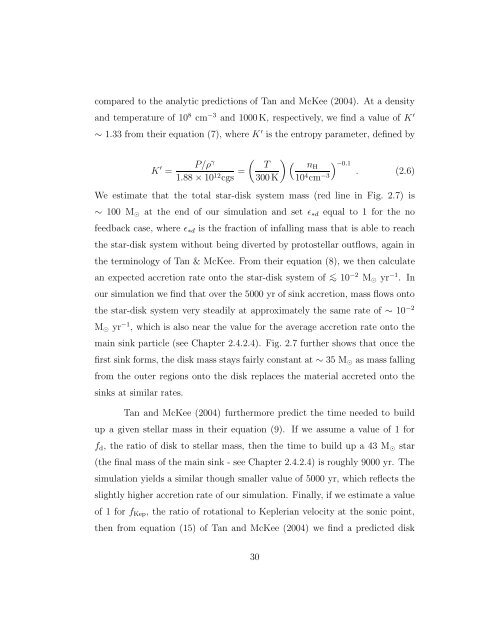Copyright by Athena Ranice Stacy 2011 - The University of Texas at ...
Copyright by Athena Ranice Stacy 2011 - The University of Texas at ...
Copyright by Athena Ranice Stacy 2011 - The University of Texas at ...
Create successful ePaper yourself
Turn your PDF publications into a flip-book with our unique Google optimized e-Paper software.
compared to the analytic predictions <strong>of</strong> Tan and McKee (2004). At a density<br />
and temper<strong>at</strong>ure <strong>of</strong> 10 8 cm −3 and 1000 K, respectively, we find a value <strong>of</strong> K ′<br />
∼ 1.33 from their equ<strong>at</strong>ion (7), where K ′ is the entropy parameter, defined <strong>by</strong><br />
K ′ =<br />
P/ργ 1.88 × 1012cgs =<br />
<br />
T<br />
<br />
300 K<br />
nH<br />
10 4 cm −3<br />
−0.1<br />
. (2.6)<br />
We estim<strong>at</strong>e th<strong>at</strong> the total star-disk system mass (red line in Fig. 2.7) is<br />
∼ 100 M⊙ <strong>at</strong> the end <strong>of</strong> our simul<strong>at</strong>ion and set ɛ∗d equal to 1 for the no<br />
feedback case, where ɛ∗d is the fraction <strong>of</strong> infalling mass th<strong>at</strong> is able to reach<br />
the star-disk system without being diverted <strong>by</strong> protostellar outflows, again in<br />
the terminology <strong>of</strong> Tan & McKee. From their equ<strong>at</strong>ion (8), we then calcul<strong>at</strong>e<br />
an expected accretion r<strong>at</strong>e onto the star-disk system <strong>of</strong> < ∼ 10 −2 M⊙ yr −1 . In<br />
our simul<strong>at</strong>ion we find th<strong>at</strong> over the 5000 yr <strong>of</strong> sink accretion, mass flows onto<br />
the star-disk system very steadily <strong>at</strong> approxim<strong>at</strong>ely the same r<strong>at</strong>e <strong>of</strong> ∼ 10 −2<br />
M⊙ yr −1 , which is also near the value for the average accretion r<strong>at</strong>e onto the<br />
main sink particle (see Chapter 2.4.2.4). Fig. 2.7 further shows th<strong>at</strong> once the<br />
first sink forms, the disk mass stays fairly constant <strong>at</strong> ∼ 35 M⊙ as mass falling<br />
from the outer regions onto the disk replaces the m<strong>at</strong>erial accreted onto the<br />
sinks <strong>at</strong> similar r<strong>at</strong>es.<br />
Tan and McKee (2004) furthermore predict the time needed to build<br />
up a given stellar mass in their equ<strong>at</strong>ion (9). If we assume a value <strong>of</strong> 1 for<br />
fd, the r<strong>at</strong>io <strong>of</strong> disk to stellar mass, then the time to build up a 43 M⊙ star<br />
(the final mass <strong>of</strong> the main sink - see Chapter 2.4.2.4) is roughly 9000 yr. <strong>The</strong><br />
simul<strong>at</strong>ion yields a similar though smaller value <strong>of</strong> 5000 yr, which reflects the<br />
slightly higher accretion r<strong>at</strong>e <strong>of</strong> our simul<strong>at</strong>ion. Finally, if we estim<strong>at</strong>e a value<br />
<strong>of</strong> 1 for fKep, the r<strong>at</strong>io <strong>of</strong> rot<strong>at</strong>ional to Keplerian velocity <strong>at</strong> the sonic point,<br />
then from equ<strong>at</strong>ion (15) <strong>of</strong> Tan and McKee (2004) we find a predicted disk<br />
30









